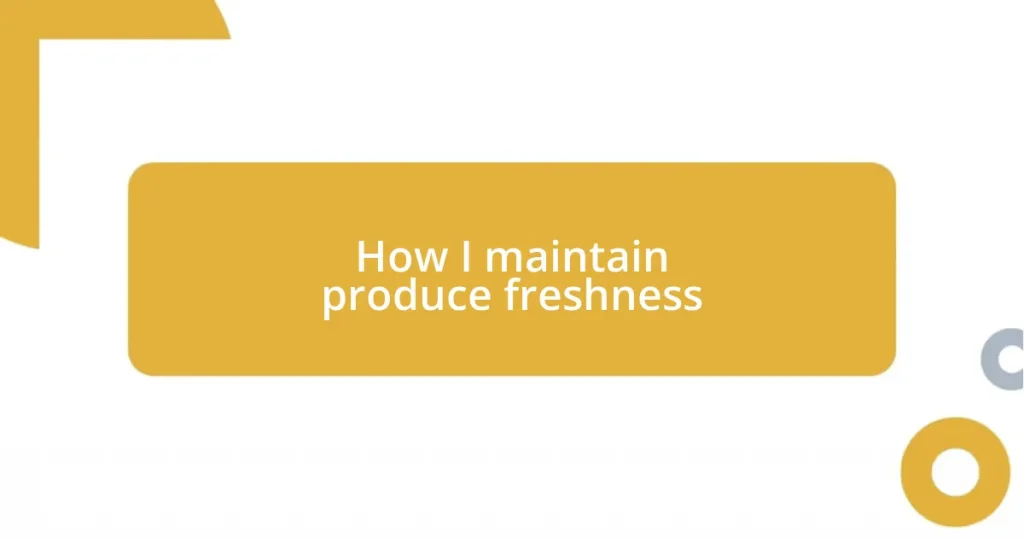Key takeaways:
- Fresh produce is more nutritious and flavorful; vibrant colors often indicate freshness.
- Proper storage techniques, such as separating fruits and vegetables and controlling humidity, can extend produce lifespan.
- Each type of produce has ideal storage temperatures; for example, store tomatoes at room temperature for best flavor.
- Using breathable produce bags and keeping them clean are essential for maintaining freshness and preventing spoilage.

Understanding produce freshness
When I think about produce freshness, I often remember the thrill of biting into a perfectly ripe peach, its juice dribbling down my chin. Fresh produce not only tastes better, but it also packs a higher nutritional punch. Have you ever noticed how vibrant colors in fruits and vegetables often indicate their freshness? That deep green of freshly harvested kale or the bright red of a cherry tomato usually means they are at their peak.
One of the best ways I’ve learned to gauge freshness is through my senses. The aroma of freshly cut herbs, the crunch of a snap pea, or even the weight of a plump tomato can tell you a lot about its freshness. I find that sometimes I can tell if something is fresh just by the way it feels in my hand – there’s a certain firmness that comes with recently picked produce. It’s fascinating how we can engage with our food beyond mere taste; have you ever experienced that sensation?
Communication with local farmers has opened my eyes even more. When I chat with them at the market, they share stories about their harvests—like how picking in the early morning dews preserves flavor. These conversations have made me appreciate the journey of the food I consume on a deeper level. Do you ever feel that connection when you learn about where your food comes from? It’s truly rewarding to know that freshness isn’t just about the produce itself, but the relationship we build with our food sources.

Best practices for storage
Storing fresh produce correctly is essential for maximizing its lifespan and retaining quality. I always ensure that I keep my fruits and vegetables in separate drawers within the refrigerator. Did you know that ethylene gas produced by ripening fruits can actually speed up spoilage in vegetables? By separating them, I’ve noticed that my kale and broccoli last significantly longer with vibrant colors and crisp textures.
Moreover, I’ve learned that the right humidity levels can make a huge difference. For instance, leafy greens thrive in high humidity, while apples do best in a drier environment. I often place a damp paper towel around greens in a sealed bag to maintain moisture. This simple trick not only keeps them fresh but also saves me from early trips to the grocery store when I’m craving a salad.
It’s also worth considering the importance of container choice. I prefer using breathable bags or containers designed for produce, as they help regulate airflow. I’ve found that using these kinds of storage solutions has extended my blueberries’ life by nearly a week—enough time for me to enjoy them in my morning oatmeal or as a snack. Have you tried these techniques yet? They might just become your new go-tos for keeping your produce fresher!
| Produce Type | Storage Method |
|---|---|
| Leafy Greens | High humidity in sealed bags with damp paper towels |
| Apples | Drier environment, separate from other produce |
| Berries | Breatheable containers, refrigerate |

Ideal temperature for different produce
When it comes to the ideal temperature for different produce, I’ve personally found that each type has its quirks that can significantly affect freshness. For instance, I used to store my tomatoes in the refrigerator, thinking it was the best way to keep them fresh. But over time, I learned that this actually affects their flavor and texture. Tomatoes thrive best at room temperature, where they can develop their full flavor profile. This little adjustment transformed my homemade salsa into a vibrant and tasty experience!
Here’s a breakdown of the ideal temperatures for various types of produce:
- Tomatoes: Store at room temperature (60-70°F) for optimal taste and texture.
- Leafy Greens: Keep in the refrigerator (32-35°F) to maintain crispness without wilting.
- Berries: Refrigerate at around 32°F to prevent mold and prolong freshness.
- Citrus Fruits: Ideal at room temperature (50-60°F) to preserve their juiciness.
- Root Vegetables: Store in a cool, dark place (50-60°F) for maximum longevity.
Every time I tweak my storage practices, I’m reminded of the simple joys that come with fresh produce. It’s incredible how just the right temperature can transform an ordinary meal into something extraordinary. What small changes have you made that really enhanced your cuisine?

Importance of humidity control
Humidity control is vital for keeping produce fresh because it directly affects moisture retention. I recall a time when I neglected the humidity levels for my herbs, leading to wilted basil. After that experience, I understood how crucial it is to maintain a humid environment for those delicate greens. Freshness is not just about keeping them cold; it’s about ensuring they have the right moisture levels to thrive.
In my kitchen, I’ve noticed that veggies stored in low humidity tended to dry out quickly. For example, I once left bell peppers in a container that wasn’t designed for produce, and they lost their crunch within days. Since then, I’ve switched to using perforated bags that allow airflow while retaining essential moisture. Have you ever experienced the disappointment of trying to revive a shriveled vegetable?
Finding that balance in humidity not only keeps my produce vibrant but also extends its shelf life, which I genuinely appreciate. Humidity plays such a significant role, like with my cilantro; the moment I placed it in a jar with a little water and loosely covered it, I saw the leaves perk up almost instantly. It’s amazing to realize that a small adjustment can transform how long I can enjoy my herbs, isn’t it?

Techniques for washing produce
When it comes to washing produce, I’ve learned that freshness often starts with a good cleanse. I vividly remember the first time I bought fresh strawberries for a dessert, but I didn’t rinse them properly. The result? A mouthful of grit that nearly ruined the entire experience! Now, I always soak my berries in a mixture of cold water and vinegar for about five to ten minutes. This simple technique not only cleans off dirt and bacteria but also helps them last longer in the fridge.
For leafy greens, I have a little ritual that I’ve come to swear by. After a visit to the farmers’ market, I rinse my greens under running water while gently moving them around. I actually find it therapeutic to watch the dirt wash away. Additionally, I use a salad spinner afterward; it’s like giving the greens a refreshing spa treatment. Have you ever considered how much fresher your salads might taste with simply washed greens?
Finally, drying the produce properly is key. I used to let my veggies air dry on the counter, but I found that excess water created the perfect environment for spoilage. Now, I gently pat them with a clean towel or use the salad spinner to remove moisture. This little adjustment has made such a difference in how long my produce lasts. There’s something deeply satisfying about biting into crisp, fresh produce without the worry of it going bad too soon, don’t you think?

Using produce bags effectively
Using the right type of produce bag has transformed how I keep my fruits and vegetables fresh. I remember a time when I’d just toss everything into regular plastic bags, and by the end of the week, my veggies were limp and lifeless. Since switching to breathable produce bags, I’ve found that they maintain a better humidity balance. The little vents allow moisture to escape, preventing the soggy mess I used to encounter. It’s remarkable how protecting my produce from ethylene gas with these bags can prolong its life—have you ever noticed how bananas accelerate the ripening of other fruits?
I also like to categorize my produce when using bags. For instance, I keep my apples and oranges in one bag and my leafy greens in another. This separation helps reduce spoilage, as some foods emit gases that can hasten decay in others. I once mixed apples with cilantro, and the next time I reached for the herb, it was lifeless and sad. Now, with my dedicated produce bags for specific items, I can optimize freshness, and I can’t tell you the joy I feel when ripping open a bag full of crisp greens!
Don’t overlook the importance of washing the bags after use. After a particularly busy week filled with travel, I found myself in a situation where my once-fresh veggies started to smell a bit off. I realized that I hadn’t cleaned my produce bags properly, leading to a lingering odor that made me question their safety. Now, I’ve made it a practice to hand wash them regularly, which adds that extra layer of reassurance. It feels good to know that my produce is stored in a clean environment—who wouldn’t want that peace of mind when preparing a meal?















